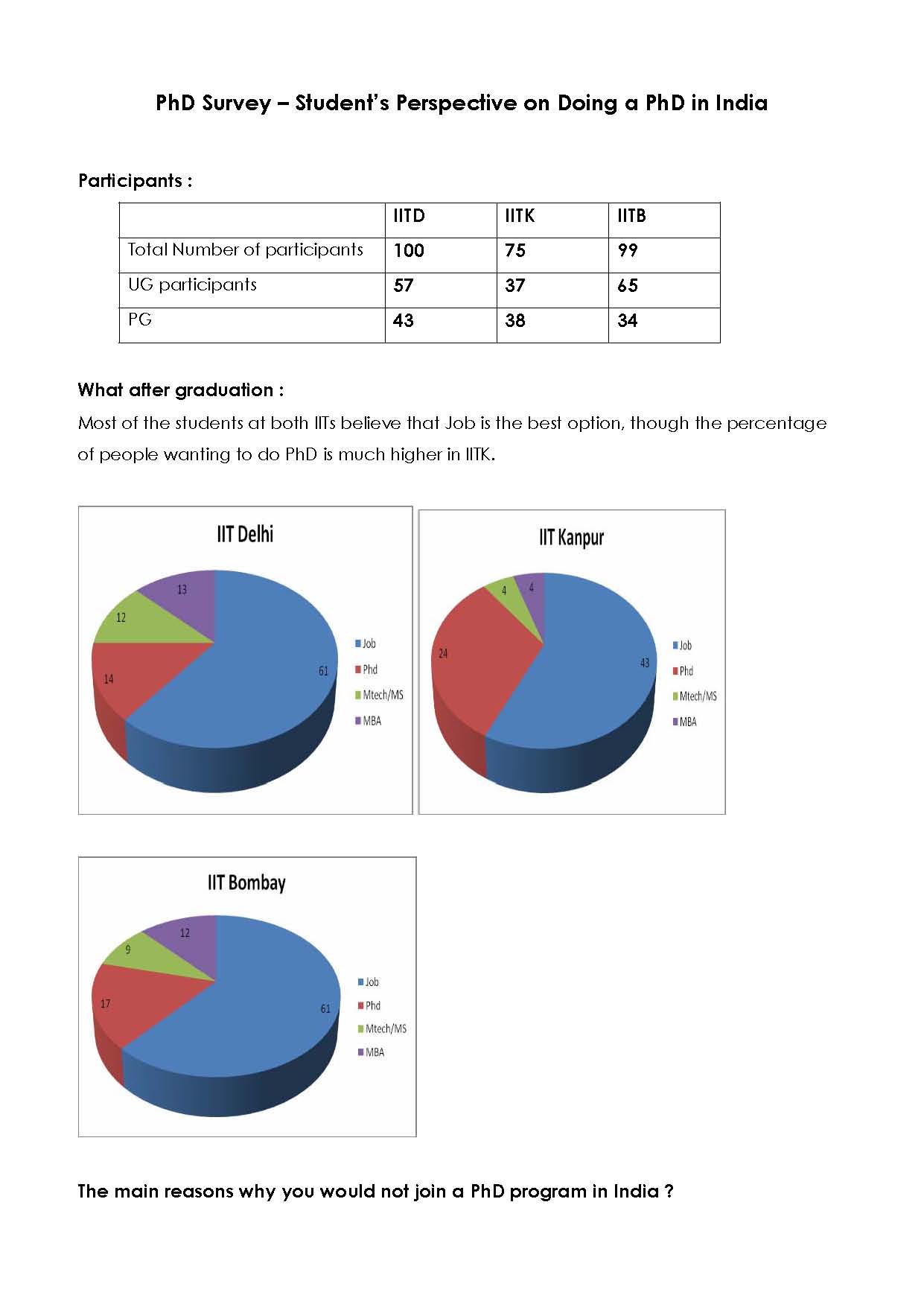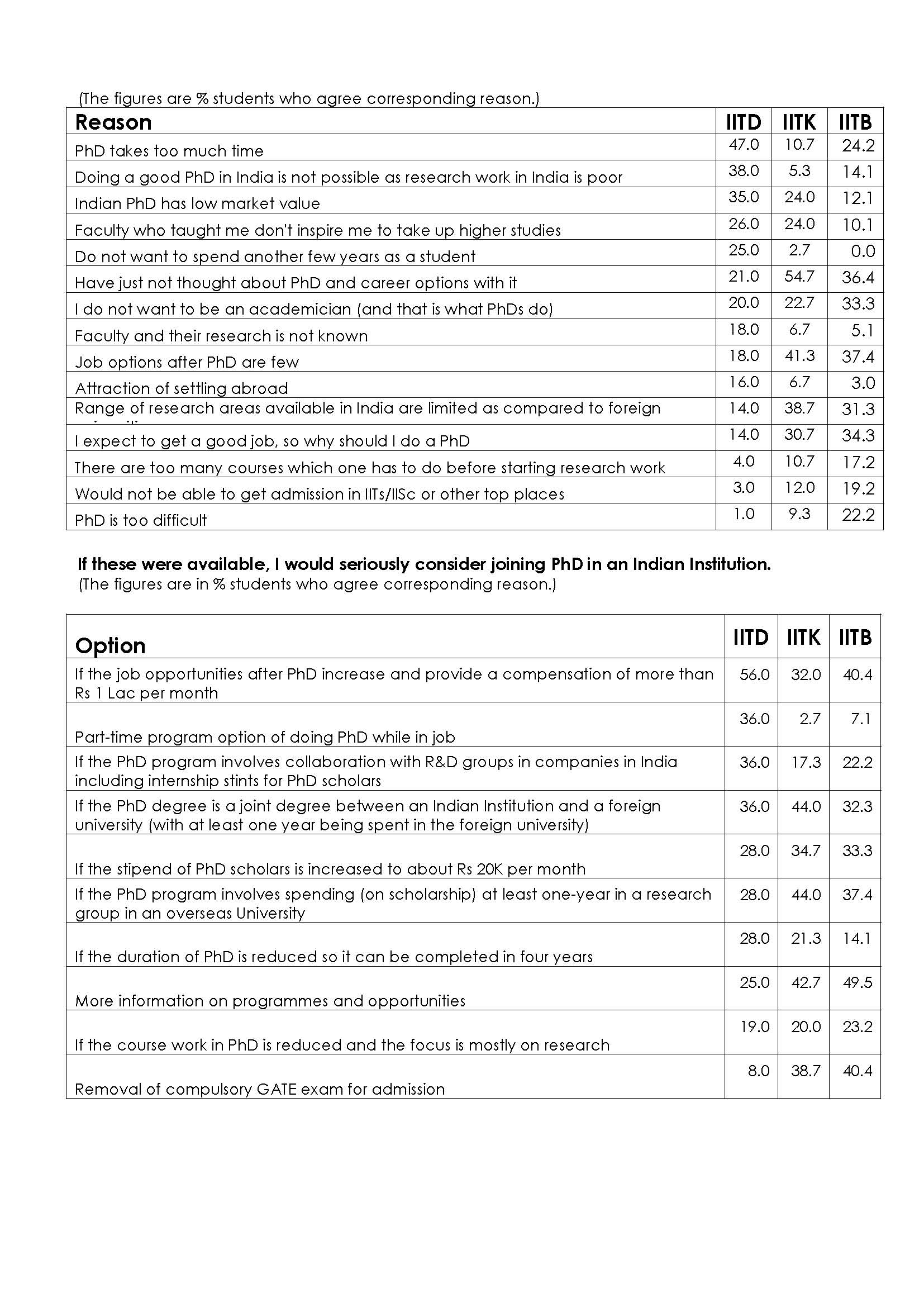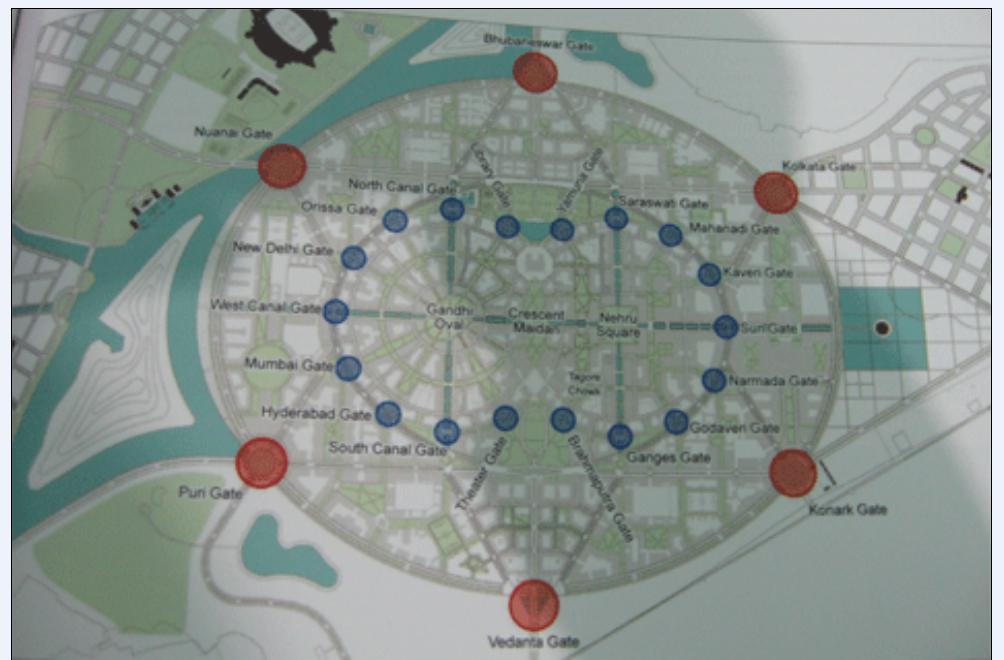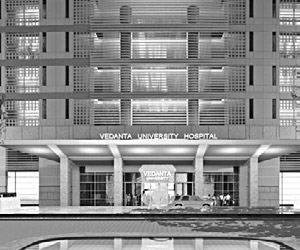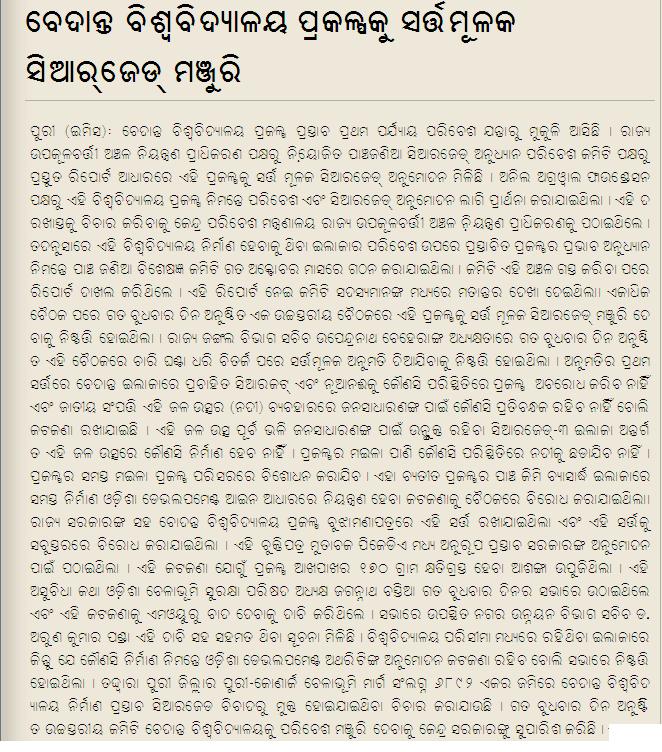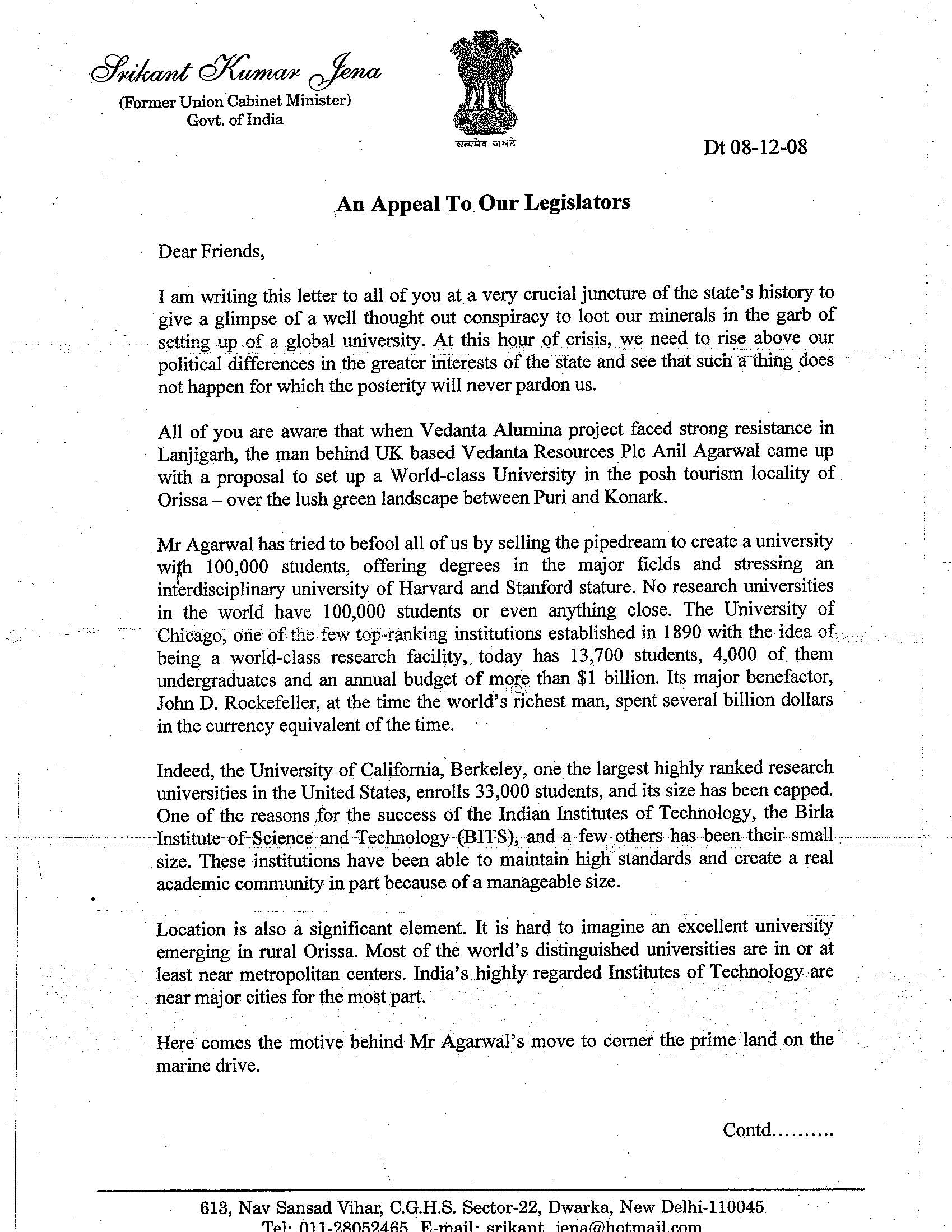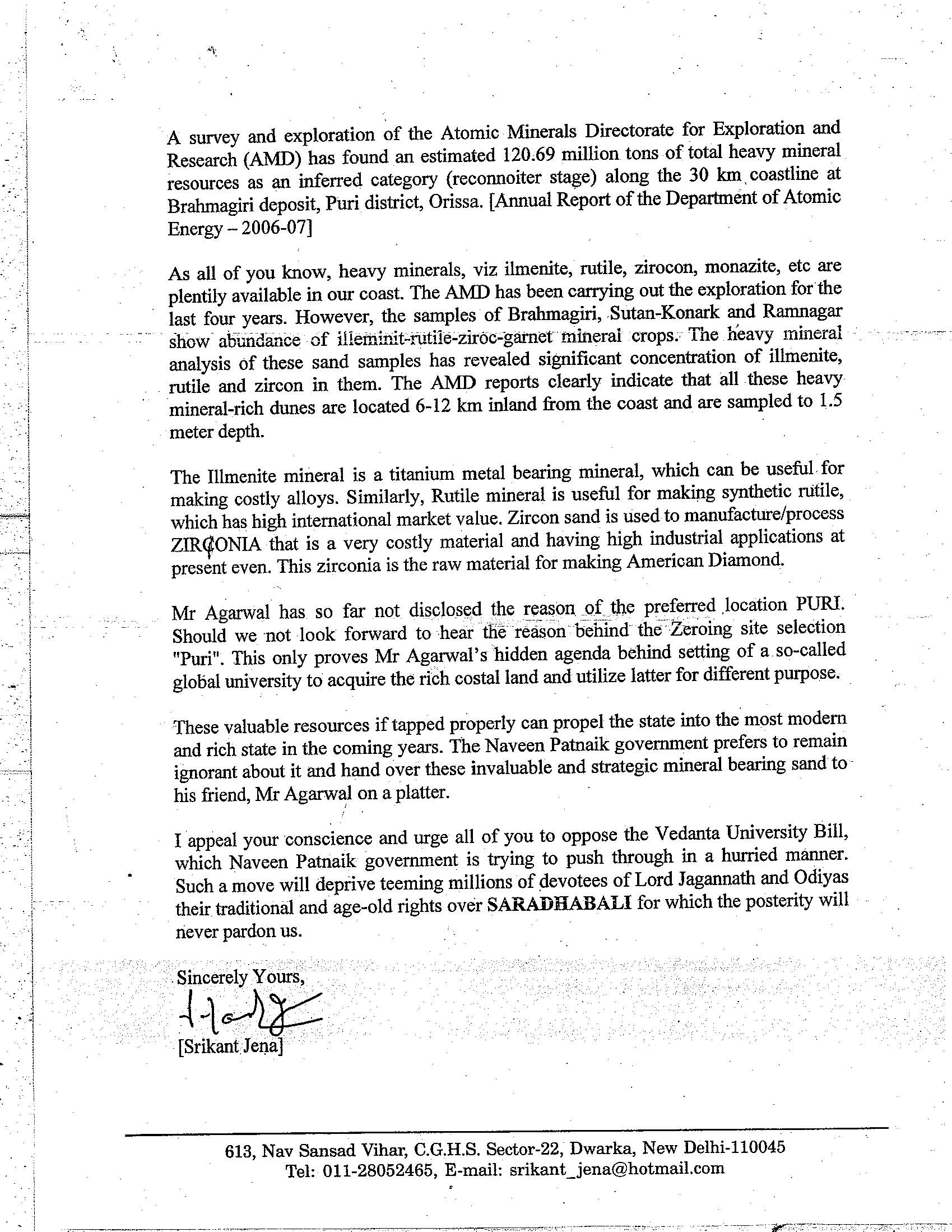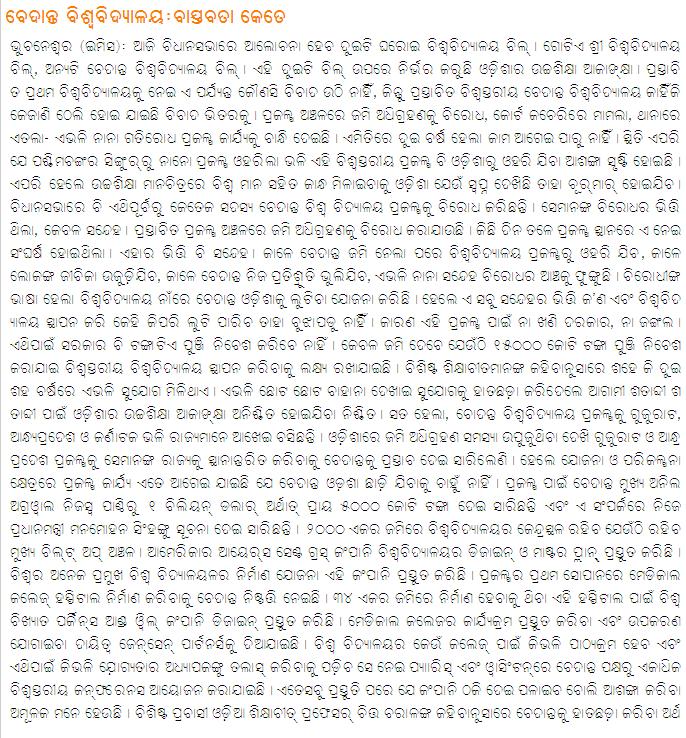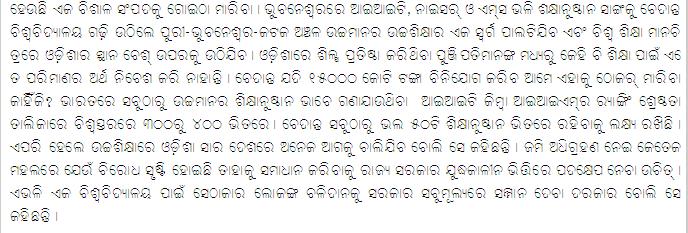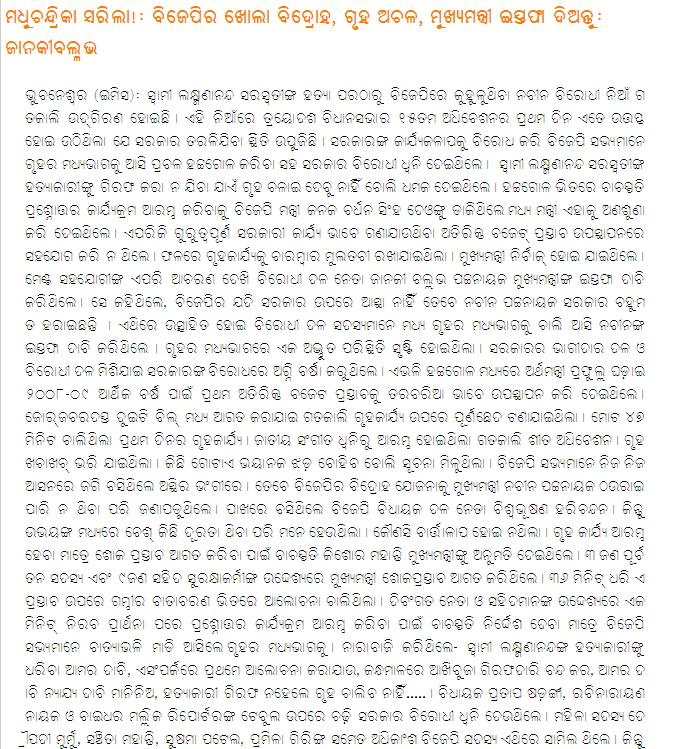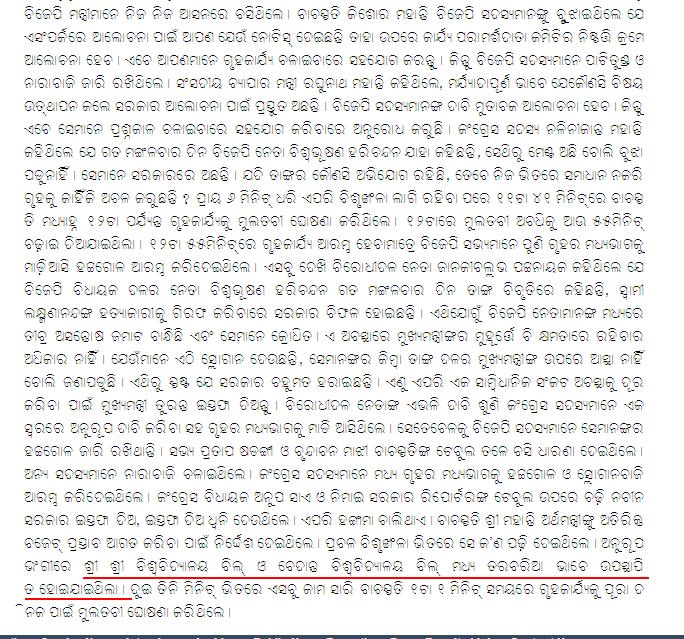Various reports (Economic Times,PTI) mention that Orissa government has introduced bills for three private universities. They are: Vedanta University, Sri Sri University and ICFAI University.
In this context it should be noted that the UGC currently (as of June 2009) recognizes 42 such private state universities in India. None of them are in Orissa. This list of 42 universities obtained from the UGC site http://www.ugc.ac.in/notices/updatedpriuniver.pdf is as follows:
CHHATTISGARH
1. Dr. C.V. Raman University, Kargi Road, Kota, Bilaspur.
2. MATS University, Arang Kharora Highway, Gram Panchayat: Gullu, Village: Gullu, Tehsil : Arang, District: Raipur.
GUJARAT
3. Dhirubhai Ambani Institute of Information and Communication Technology, Gandhinagar, Post Box No. 4, Gandhinagar-382 007.
4. Ganpat University, Ganpat Vidyanagar, Mehsana, Goazaria Highway, District Mehsana – 382 711
5. Kadi Sarva Vishwavidyalaya, Sarva Vidyalaya Campus, Sector 15/23, Gandhinagar.
6. Nirma University of Science & Technology, Sarkhej, Gandhinagar Highway, Village- Chharodi, Ahmedabad.
7. Pandit Deendayal Petroleum University, At Raisan, Dist. Gandhinagar – 382 009.
HIMACHAL PRADESH
8. Chitkara University, HIMUDA Education Hub, Kallujhanda (Barotiwala), Distt. Solan, – 174103 Himachal Pradesh
9. Jaypee University of Information Technology, District-Solan-173 215.
MEGHALYA
10. Martin Luther Christian University, KIPA Conference Centre, Central Ward, Shillong – 793 001.
11. Techno Global University, Anita Mension Bishnupur, Lawsohtun Road, Shillong – 793004.
MIZORAM
12. The Institute of Chartered Financial Analysts of India University, Salem Veng, Chaltlang, Aizawal – 798 012.
NAGALAND
13. The Global Open University, Wokha – 797 111.
PUNJAB
14. Lovely Professional University, Jalandhar –Ludhiana, G. T. Road, Near Chehru Railway Bridge, Phagwara, District – Kapurthala – 144 002.
RAJASTHAN
15. Bhagwant University, Post Box No. 87, Sikar Road, Ajmer – 305 001.
16. Jagannath University, Village-Rampura, Tehsil-Chaksu, Jaipur.
17. Jaipur National University, Jagatpura, Jaipur.
18. Jyoti Vidyapeeth Women’s University, Vedant Gyan Valley Village, Jharna Matpala Jabner, Link Road NH-8, Jaipur.
19. Mewar University, Chittorgarh.
20. NIMS University, Shobha Nagar, Jaipur – 303 001.
21. Sir Padmapat Singhania University, Pacheribari, Jhunjhunu.
22. Singhania University, Pacheribari, Jhunjunu.
23. Suresh Gyan Vihar University, Mahal Jagatpura, Jaipur.
24. Jodhpur National University, Narnadi Jhanwar Road , Jodhpur -342001 ,Rajasthan.
25. Amity University, Rajasthan NH-11C,Kant Kalwar, Jaipur- 303002
SIKKIM
26. Eastern Institute for Integrated Learning in Management University, Jorethang.
27. Sikkim- Manipal University of Health, Medical & Technological Sciences, Gangtok-737 101.
TRIPURA
28. Institute of Chartered Financial Analysts of India (ICFAI), Agartala – 799001.
UTTAR PRADESH
29. Amity University, NOIDA, (UP)
30. Integral University, Kursi Road, Lucknow-226 026.
31. Jagadguru Rambhadracharya Handicapped University, Chitrakoot Dham-210 204.
32. Mangalayatan University, Aligarh.
33. Mohammad Ali Jauhar University, Rampur.
34. Sharda University, Gautam Budh Nagar, U.P.
35. Swami Vivekanand Subharti University, Delhi-Haridwar Byepass Road, Meerut.
36. Teerthanker Mahaveer Univesity, Delhi Road, Moradabad.
UTTRAKHAND
37. Dev Sanskrit Vishwavidyalaya, Gayatrikunj, Shantikunj, Hardwar-249 411.
38. Doon University, Campus Office, 388/2, Indira Nagar, Dehradoon.
39. Himgiri Nabh Vishwavidyalaya (University in the Sky), Dehradun.
40. Institute of Chartered Financial Analysts of India (ICFAI), C-1/103, Indira Nagar, Dehradun-248 006.
41. University of Petroleum and Energy Studies, Building No. 7, Street No. 1, Vasant Vihar Enclave, Dehradun-284 006.
42. University of Patanjali, Patanjali Yogpeeth, Haridwar.
In that document, after giving the list, the notice says the following:
These universities are competent to award degrees as specified by UGC under Section 22 of the UGC Act and with the approval of the statutory councils, wherever required through their main campus. Wherever the approval of the statutory council is not a pre-requisite to start a programme, the universities are required to maintain the minimum standards regarding academic and physical infrastructure as laid down by the concerned statutory council.
It is also informed that private universities cannot affiliate an institution/college. They cannot establish off campus centre(s) beyond the territorial jurisdiction of the concerned State. However, they can establish off-campus centre(s) within the concerned State after their existence of five years and with the prior approval of the University Grants Commission. So far, UGC has not approved any off campus centre(s) of any Private University.
Approval letters for course under distance mode should clearly state that the course has been approved by the Joint Committee UGC, AICTE and DEC and the approval letter should be jointly signed by Secretary UGC , Member Secretary, AICTE and Director, DEC as per the provision laid down under clause 9 of the MOU signed by UGC, AICTE and DEC.
Students/Public at large are advised to go through this website carefully before taking admission in any of the above State Private Universities and report the matter to Secretary, UGC on finding any violation of the above provisions.
Interestingly, none of the above are in the southern states (Andhra Pradesh, Tamil Nadu, Karnataka and Kerala) or Maharastra which took a huge lead in establishing engineering colleges.
July 25th, 2009
Some news reports mention about opposition to certain conditions in the Vedanta University act. In this regard a recent article by Ila Patnaik in Indian Express is illuminating. Following are some excerpts.
The existing framework for running universities in India has been tried for many decades, and has been shown to have failed. In striking contrast, China has been able to get far ahead of India in building universities. If progress has to be made in India, every assumption of the HRD ministry now needs to be questioned. In addition to removing entry barriers against new private or foreign universities, the four new ideas that need to be brought in are: autonomy of universities (including on budget); reduced core funding combined with more competitive research grants; a flexible salary structure; end of government interference in recruitment of staff and students.
The best universities in India, those that we are particularly proud of, are not well rated by international standards. The Times of London’s Higher Education Supplement ranks universities around the world. In 2008, their data showed IIT Delhi at rank 154 and IIT Bombay at rank 174 globally. No other university in India made this top 200 list. By way of comparison, China has universities at ranks 50, 56, 113, 141, 143 and 144. In other words, China has six universities which are superior to IIT Delhi and IIT Bombay.
Last week, the NBER Digest carried an article by Linda Gorman summarising a research paper by Philippe Aghion, Mathias Dewatripont, Caroline M. Hoxby, Andreu Mas-Colell and Andre Sapir which investigates the sources of success in building universities. The paper is immensely useful in thinking about how to build universities in India; it should be on the top of Kapil Sibal’s reading list.
The paper finds that the first element that pulls down the rank of a university is the process of budgetary approval from the government. The average European university that sets its own budget has a rank of 200 while the average European university that needs approval from the government has a rank of 316. In other words, giving a university autonomy to set its own budget on average yields an improvement of 116 ranks. The message for India: in order to obtain high-quality universities, we need to give universities autonomy.
The second important feature is the role of government in funding universities. They find that each percentage point of the university’s budget that comes from core government funds reduces the rank of the university by 3.2 points. The message for India: in order to obtain high-quality universities, we need to give them less money through core funding from the government.
The third issue is inequality in wages. European universities which pay the same wages to all faculty of the same seniority and rank have an average rank of 322. Universities which vary wages for each faculty member and pay different salaries to two people of the same seniority and rank, have an average rank of 213. In other words, flexible HR policies yield an improvement of 109 ranks. The message for India: freeing up HR policies is essential to building high-quality universities.
The fourth issue is the recruitment process for students. Universities which are free to recruit undergraduate students as they like have a rank 156 points higher than those where the government determines the composition of students. The message for India: universities should have full freedom to recruit students as they like, without interference from the government.
The fifth issue is competition. Each percentage point of a university’s budget that comes from a competitive research grants process yields an improvement in its ranking by 6.5. …
Variation across state governments in the United States shows that the best universities come up in states which allow more autonomy, such as independent purchasing systems, no state approval of the university budget, and complete control of personnel hiring and pay.
There is only one university in India which has autonomy on budget setting, recruits its own students, has flexible HR policies, etc., and this is the Indian School of Business. It is perhaps logical that, in 2008, ISB was ranked the 20th best MBA programme by The Financial Times, and in 2009 this rank was improved to 15. None of the IIMs feature anywhere. This is a striking contrast between enormous state expenditures on the IIMs failing to yield measurable results when compared with an alternative which has landed India in the top rankings of the world.
July 21st, 2009
Following are some excerpts from that article.
… The university hospital, which will be built near the Puri-Konark Marine Drive, will be distinctive with its world-class facilities and infrastructure. The hospital will place equal emphasis on patient care, research, and teaching. It will be staffed by renowned doctors from India and abroad. …
Commending this initiative, eminent Indian cardiologist Dr KP Misra, said, "The hospital will serve as a regional hub for critical specialties including cardiology and diabetology. As a teaching and research hospital, it will attract leading researchers and specialists in medical science from around the globe. The university’s research agenda will prioritise public health solutions that address the most prevalent medical issues in the region."
On the occasion of the launch of the Vedanta University hospital project, a national seminar on ‘Optimum Medical Education and Ethics in Clinical Practice’ was organised at Bhubaneswar. The national conference was addressed by leaders in medical science of international repute, including Padma Vibhushan Professor MS Valiathan and Padma Bhushan Professor NK Ganguly.
The conceptual planning and design of the hospital has been prepared by the leading US-based hospital design firm Perkins + Will, which has previously designed state-of-the-art teaching and research hospitals at institutions such as Johns Hopkins University and the University of California at Los Angeles.
"The 500-bed multi-specialty hospital will commence during the first phase of the University. Orders for construction have already been placed with Larsen & Toubro Limited," added Sanjeev Anand Zutshi, Director of the project. The university has already initiated research programmes with local relevance. Dr Dipika Mohanty, a recipient of the Biju Patnaik award for Excellence in Science and Technology, has begun a Vedanta University-sponsored research project on interventions that can address the disproportionate prevalence of anemia in infants and children of Orissa.
The Vedanta University Hospital is a cornerstone of the institution’s larger commitment to serving public needs. Students and faculty across disciplines will be encouraged to engage with local challenges, search for solutions that contribute to the development of Orissa, and pursue research priorities that have real impact on the lives of people. In addition to initiatives in medicine, the first phase of the University will include schools of education, arts & sciences, engineering, management, and nursing. The hospital and initial academic programs will begin in 2011.
June 12th, 2009
Following is an excerpt from a PTI report in indopia.in.
Vedanta University today announced the launch of a world class multi-speciality teaching and research hospital near Puri-Konark Marine Drive at a cost of Rs 400 crore. "The 500-bed multi-speciality hospital will commence during the first phase of the university. Orders for construction have already been placed," Sanjeev Anand Zutshi, Director of the project, told reporters here.
Stating that construction would begin after the elections, C V Krishnan of the Vedanta group said nearly 4,000 acres had already been acquired for the university project as against the total requirement of about 6,000 acres.
Both Krishnan and Zutshi said that the hospital would commence services in 2011 providing high-quality patient care affordable to the common man by the "not-for-profit"institution, an initiative of Anil Agarwal foundation.
Following are excerpts from a report in tathya.in.
Lauding the initiative, eminent Indian cardiologist, Dr. Kabi Prasad Mishra, said that the hospital will be a regional hub for critical specialties including cardiology and diabetology.
Dr.Mishra said that as a teaching and research centre, it will attract leading researcher and specialists in medical science from around the globe.
The University’s research agenda will prioritize public health solutions that address the most prevalent medical issues in the region.
This multi-specialty hospital will commence during the first phase of the university, said Sanjeev Anand Zutshi, Director of VUP.
Orders for construction have already been places with Larsen & Toubro Limited, added Mr.Zutshi.
The conceptual planning and design of the hospital has been prepared by the leading US based hospital design firm Perkins + Will.
The design was well appreciated by stalwarts of Medical Science like Professor M S Valiathan and Professor N K Ganguly.
Padma Vibhusan Dr. Valiathan presented the key note address in the national seminar “Optimum Medical Education and Ethics in clinical Practice”.
Padma Bhusan Dr.Ganguly dwelt upon issues like immunology, biotechnology and public health.
The VUP has already initiated research program on interventions needed for prevalence of anemia in infants and children of the state led by Dr.Dipika Mohanty.
Telegraph also reports on this.
April 6th, 2009
Following are excerpts from a recent (March 19, 2009) report in Business Standard.
The Anil Agarwal-promoted Vedanta University will begin operations by mid-2011 in Puri, Orissa. Agarwal plans to make Vedanta University into a world-class, multi-disciplinary varsity with students from across India and around the world.
The university, being built with an investment of Rs 15,000 crore, will come up in three phases. Phase one will be operational by mid-2011 with an investment of Rs 5,000 crore. The first academic session at the university was to begin in 2009 but the project has been delayed by two years due to a land acquisition tussle with the local residents of Puri.
… To begin with, the university will start operations with around 1,000 students in the arts and science streams. The student intake, however, will grow steadily to reach an ultimate goal of 100,000 students. The university board on the other hand is still working on the modalities involving admission and fee structure.
“We have all the necessary approvals in place from various academic authorities in the country. However, certain details regarding the admission process need to be worked on. We plan to produce professionals far superior to what any other institute can produce in the country,” said C V Krishnan, CEO, Vedanta University.
The university has awarded construction contracts of the academic buildings as well as the hospital at the project site to companies like Larsen & Toubro, Shapoorji Pallonji, Ahluwalia, B E Billimoria and Simplex. Architects Ayers Saint Gross of Baltimore, USA, have prepared the master plan of the University.
The campus will have a super specialty hospital, which will answer a long standing need for providing comprehensive and specialised patient care for the people of Orissa and eastern India. Both the University and the hospital are ‘not-for-profit’ institutions.
World-renowned hospital architects are developing the design for the hospital, Perkins and Will from USA. The university will also establish research parks to promote science and technology-based entrepreneurship and support an innovation-driven incubator. E-learning programmes will also be launched in future.
“We will be recruiting young professors with inclination towards research. We have already hired a US-based recruitment agency to appoint faculty for the university,” added Krishnan.
April 5th, 2009
(Update 15th March 2009: Rediff reproduces the main Forbes article here and there are a lot of comments to that article.)
The article is at http://www.forbes.com/global/2009/0316/044_campus_politics.html. There is also a sidebar article at http://www.forbes.com/global/2009/0316/044_higher_education.html . The same issue also lists Anil Agarwal among the top 48 philanthropists and says the following:
Anil Agarwal
Country: India
Age: 55
Chairman of mining outfit Vedanta Resources.
Pledged $1 billion to build a new university in the eastern state of Orissa. Apart from arts and sciences, medicine and engineering, it plans research centers for bio- and nanotechnology, crop genetics and alternative energy. The timetable calls for the first students to arrive on campus in 2011.
Following are excerpts from the main article:
Indian mining magnate Anil Agarwal is having a tough time giving away a billion dollars. He’s pledged $1 billion to start a university along the shores of the Bay of Bengal in eastern India’s Orissa state. The grand plan for a 6,000-acre campus looks to Stanford University in California for inspiration. Leading academics would be poached from every corner of the globe. Research centers in bio- and nanotechnology, crop genetics and alternative energy would produce important work. His ultimate dream: When every building is completed and every classroom filled, 100,000 students will be enrolled, making it one of the largest universities in the world on a single campus. A more realistic goal is 10,000 students in the first eight years and double that in the next four. Ground-breaking is expected this month.
No one doubts that India needs more universities. And this would be the country’s most comprehensive, with medical, engineering and business schools all on one campus. But Agarwal’s plan is under attack on all sides. Critics say there is too much secrecy surrounding the land purchases, and they don’t understand why he needs so much land. They point to 18 villages that are in the way–7 will be displaced completely–and water supplies that will be depleted. In November a mob armed with sticks broke up a prayer service to start construction on a highway to the campus, attacked the attendees and damaged some of the construction equipment. The protests have set back the project by two and a half years. What’s more, government approvals have either already expired or been held up.
At the same time Agarwal’s company, Vedanta Resources, is under fire for its mining operation 250 miles away on the other side of Orissa. Its attempt to mine bauxite will destroy the ecology there and force out a tribal community, environmentalists claim. In January tribal members formed a 10-mile human chain in protest. Given all this, even the four academics planning the university are wary of becoming too deeply involved in the project until a clear line is drawn between the university and the company. Agarwal is in complete agreement, but the legislation to formalize that is being held up.
Agarwal, 55, built his fortune through London-listed Vedanta, which operates in India, Australia and Zambia, and mines copper, aluminum, zinc and iron ore. He owns 55% of the company and with the crash in commodity prices, he has seen his net worth plunge from $7.4 billion in November 2007 to $2.4 billion last November. He hasn’t wavered in his philanthropic commitment, though. He still says he will donate 75% of his wealth to the Anil Agarwal Foundation, and the money for the university will come from this. He’s already transferred $250 million to the foundation for the project, but won’t say how much he’s spent on the land and the other costs so far.
Agarwal’s pet cause has always been education, though he didn’t make it to college himself. He credits his father, Dwarka Prasad Agarwal, with the idea of building a university. "My father [who didn’t go to college either] reads a lot," he says. "He told me that great higher education was fundamental to where the U.S. is today. It had the vision, and it created a mass [higher] education system. Because of that it’s produced the best politicians, huge liberal arts programs, best medical research. I always felt that India should have that."
… For the brainstorming session on an engineering school, for instance, he pulled in participants from the National Science Foundation, ucla, Stanford, Princeton, the University of Illinois at Urbana-Champaign and other places. For the session on a business school, participants came from Oxford, Wharton, the Indian Institute of Management, Insead and Nanyang in Singapore. Most of them were of Indian origin.
Agarwal hired Ayers Saint Gross, a Baltimore, Maryland specialist in campus architecture, to design the university, and he wants to move ahead at full speed. But the Indian bureaucracy and the mass protests, sometimes violent, that appear whenever a big project is proposed–such as recent plans to build a Tata car plant in West Bengal and a Posco steel plant in Orissa–have slowed him down. He wanted 10,000 acres, but he had to scale that down to 6,000 and has been able to purchase only 3,900 so far. The acquisition of so much land is a lightning rod for criticism in the region. Some 18 villages will be affected and at least 450 people must be relocated, says the foundation. Agarwal, on the other hand, cites Stanford, which is spread over 8,180 acres.
… Mehta and his academic colleagues are well aware of the controversies surrounding their benefactor. "It’s crucial for the success of the university that there’s a clear separation from the company," he says. "It’s a project in its own right and not a commercial project, and it shouldn’t be used to compensate for other activities of Vedanta. That’s what makes this genuinely philanthropic: if he just hands over this grant and is not expecting any return on this."
Shah agrees. "You’ve got someone who’s genuinely putting down his own resources," he says. "To not support that because I have ideological issues that are unrelated, to me seems to be hypocritical. The history of universities is such. Duke [in the U.S.] was built with tobacco money; this university is as genuine a philanthropic project."
March 5th, 2009
(Thanks to Abi for the pointer.)
Following is excerpted from a report in India Today.
… The academic-turned prime minister chose to call them ‘World Class Universities’, sexing up the comeget-me factor. “These universities should focus on international standards of excellence and be rated among the top institutions in the world. They must become the launching pads for our entry into the knowledge economy,” Manmohan said at a function held to celebrate 150 years of the University of Mumbai in June 2007.
… The chances of missing the February deadline to pass the bill in the short session of Parliament are high and the Government is looking at the possibility of pushing it through an ordinance.
…The UGC is of the view that the universities should be run by the government and wants to underplay the role of private players and corporates.
The ministry on its part is ready to open it up to “creditable private organisations” and offer them public land. The Knowledge Commission has a different take.
“Since public finance is an integral constituent of universities worldwide, most of the new universities shall need significant initial financial support from the Government. Each university may be endowed with a substantial allocation of public land, in excess of its spatial requirements,” says Sam Pitroda, chairman, NKC.
The excess land can be a subsequent source of income generation, he says. Exceptions need to be made in existing income tax laws to encourage large endowments.
… The NKC in its letter to the UGC chairman has also suggested that the syllabi should be revised every year to keep up with the changes and current developments in various disciplines. “Departments that do not update their syllabi for two consecutive years shall be asked to provide justifications,” says the letter. Another contentious issue is that of fixing fees and granting autonomy to the proposed universities.
The commission had envisaged that these universities shall have the autonomy to set student fee levels and tap other sources for generating funds such as industry collaborations and overseas operations. The autonomy of fees and greater autonomy for each university is a strict no-no for both the ministry as well as the UGC. Prompted by incisive memos from the Prime Minister’s Office, which is attuned with the views of the NKC, the ministry is planning to prepare a bill with critical minimum provisions, thereby enabling autonomy and innovation without going through a parliamentary process at a later stage. Otherwise, it will have to resort to the ordinance route, bypassing Parliament.
… As a first step, the ministry has decided to do away with the tag of World Class University, an idea which has won it the NKC’s applause . The Act will now be termed the National Universities System Act instead of the World Class University System Act.
Hope the people who wonder about Vedanta University’s land requirement will get a better understanding of it from the NKC’s suggestion regarding providing excess land to the proposed National Universities.
January 26th, 2009
Following is from a report in Daily Pioneer.
The State Government has allotted 6,000 acres of land, and not 8,000 acres as reported in a section of the media, to the Anil Agarwal Foundation to establish its world-class Vedanta University near the Puri-Konark marine drive.
The land would be used only for the purposes of the university as per the terms of the Government, said a project release on Monday.
The release said the Anil Agarwal Foundation is acquiring land at full market value, well beyond the Government’s land acquisition norms in terms of compensation, ex-gratia payment, rehabilitation and other facilities to the landowners.
Out of the 6,000 acres earmarked for the university, only 1,300 acres constitute the land owned by Lord Jagannath.
The temple trust has agreed to sell the land for the educational mission and the foundation is acquiring it at full and fair market value.
The release claimed that world-class universities like Stanford, Duke and Harvard have land areas of 8,180 acres, 7,200 acres and 4,940 acres, respectively. Vedanta University, 6,000 acres, would be unique with 100,000 students, 10,000 faculty and 95 academic disciplines.
Vedanta would have no control over any land near or far from its site. The Puri-Konark Development Authority and the district administration would make all decisions regarding future developments in the area.
Following are some excerpts from a tathya.in report.
The University will have its own water harvesting and recycling system and there will be no adverse impact on the availability of water for the people of Puri.
… World Class Vedanta University will put Orissa on the global education map and will further enhance the cultural significance of Puri and Konark.
It will provide continuing employment opportunity for several thousands of people in the area.
Vedanta University Project(VUP) has already undertaken many developmental programs in the areas of health, education, livelihood and peripheral development which are greatly appreciated by the local people.
December 9th, 2008
